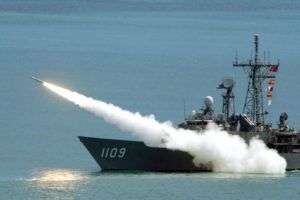Artificial intelligence in missile technology
AI • Jan 03,2017

Artificial intelligence in missile technology

The new buzzword in militaries across the world today is artificial intelligence – the ability for combat platforms to self-control, self-regulate and self-actuate, using inherent computing and decision-making capabilities. That advanced computing technologies today enable autonomous systems to identify and strike hostile targets is no surprise. There is growing interest in the subject of “intelligent” weapons systems in the maritime realm, where recent studies have shown that precision-guided weaponry and networked systems are likely to play an increasingly important role.
A good point of departure for the discussion on autonomous combat systems is a recent report in the Chinese media about the development of a family of cruise missiles with artificial intelligence capabilities. Dubbed “death drones”, the missiles will use artificial intelligence to guide themselves in flight and potentially even choose new targets.
Wang Changqing, director of the General Design Department of the Third Academy of the China Aerospace Science and Industry Corp, told China Daily that his country was leading the world in the development of AI weapons. He said: “We plan to adopt a ‘plug and play’ approach in the development of new cruise missiles, which will enable our military commanders to tailor-make missiles in accordance with combat conditions and their specific requirements.
The new missiles will be modular, which means engineers can quickly change the payload to ramp up the weapon’s destructiveness or pack it with more fuel so it can strike distant targets. These AI cruise missiles are a type of killer robot, the name given to weapons which can guide themselves into battle and choose targets. This technology is highly controversial, as academics fear it will one day lead to a world where emotionless murder machines are unleashed upon civilians. However, this scenario remains a long way away, as even the most advanced weapons require an element of human interaction in order to perform their deadly task.
Technically, AI is any onboard intelligence that allows machines in combat to execute regular tasks, allowing humans more time to focus on demanding and complex missions. Modern-day combat requires warfighters to operate with the active assistance from sensors and systems. In theory, AI provides the technology to augment human analysis and decision-making by capturing knowledge that can be re-applied in critical situations. In practice, however, artificial intelligence is a term used for a combat system that has the ability to take targeting decisions. This is more in the nature of “who to target,” as opposed to “how to target,” which is anyway a task that guided missiles have been performing with some precision.
Artificial intelligence is considered indispensable in the development of new-age naval weapons, in particular hypersonic missiles. A useful illustration of the predicament that AI poses for the naval community is the U.S. Navy’s Long Range Anti-Ship Missile or LRASM. Admiral Harry Harris, commander of the U.S. Pacific Command, wants the Navy to put LRASM into service ASAP to counter surface threats in the Chinese, Russian, and North Korean navies. LRASM is a replacement for the Harpoon missile (albeit a more powerful version) and a supposedly “intelligent” missile system. LRASM is first guided by the ship that launched it, then by satellite. The missile is jam-resistant and can carry on even if it loses contact with the Global Positioning System. As part of the targeting system, the missile can be set to fly to a series of waypoints, flying around static threats, land features, and commercial shipping. LRASM can detect threats between waypoints and navigate around them. If it decides it would be entering the engagement range of an enemy ship not on the target list, LRASM will fly around the ship, even skipping waypoints that might lie within enemy range and going on to the next one.
After locating the enemy fleet, it dives to sea-skimming altitude to avoid close-in defenses. LRASM then sizes up the enemy fleet, locates its target, and calculates the desired “mean point of impact”—the exact spot the missile should aim for, taking into account the accuracy of the missile—to ensure the missile does not miss. In most instances that is the exact center of the ship, with the angle of the ship in relation to the missile taken into consideration.
Missile guidance systems using the Proportional Navigation (PN) guidance law is limited in performance in supporting wide class of engagement scenarios with varying mission and target parameters. For surpassing this limitation, an Artificial Neural Network (ANN) to substitute the PN guidance can be used. Arvind Rajagopal and Farhan A. Faruqi from the University of South Australia proposed the ANN based system that enables learning, adaptation, and faster throughput and thus equips the guidance system with capability akin to intelligent biological organisms. This improvement could remove the barrier of limitations with allowable mission scope.
Artificial intelligence has to be applied to the machines where the human involvement is not applicable. Economical development of most of the countries depends on the strength of their military industries. Further research on the lines of missile technology using AI may fetch more advanced and better technology in designing the missiles.
Author: AI.Business
If you like our articles, please subscribe to our monthly newsletter:
[mc4wp_form id=”763″]